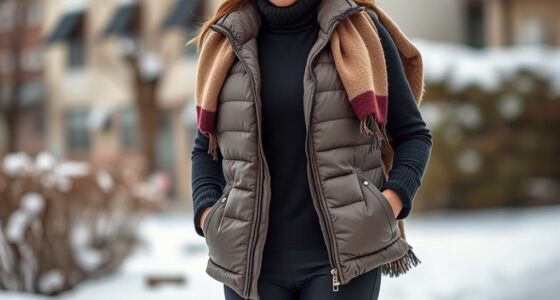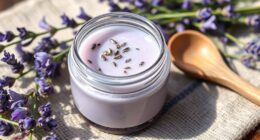To confidently mix prints and patterns, start with a neutral base like solid-colored tops or bottoms to keep things balanced. Play with color by combining complementary or contrasting hues, and vary scale by pairing bold patterns with delicate ones. Use the 60-30-10 rule to harmonize your colors, and add accessories that tie everything together. Mastering these tips will turn your pattern mixing into a stylish statement—keep exploring for more expert advice.
Key Takeaways
- Start with a neutral base, then add bold patterns and textures for balance and visual interest.
- Coordinate colors using complementary or analogous hues for harmony and contrast.
- Vary scale by pairing large prints with smaller, delicate patterns for visual contrast.
- Apply the 60-30-10 rule to distribute colors and patterns proportionally.
- Use accessories thoughtfully to unify the look and enhance pattern coordination.
Start With a Neutral Base and Add Bold Elements
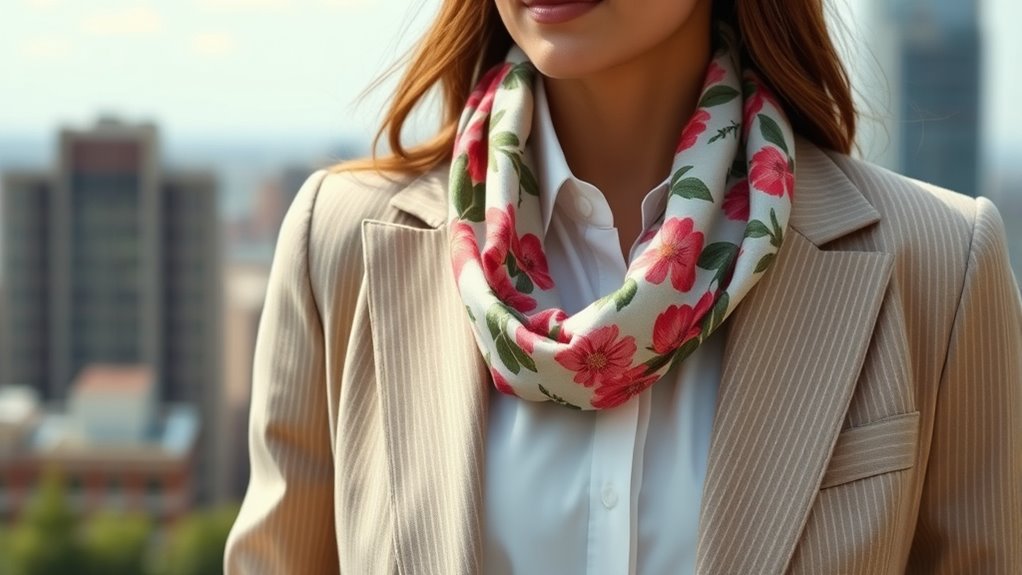
When mixing prints and patterns, it’s best to begin with a neutral base, such as a solid-colored top or pants. This helps create a balanced foundation, allowing your bold patterns to stand out without overwhelming. Pay attention to fabric textures; combining smooth and textured fabrics adds visual interest without clashing. When incorporating multiple prints, consider pattern repetition—using similar motifs or sizes throughout your outfit creates harmony. For example, if you choose a floral pattern, select another piece with subtle, recurring elements. This approach guides the eye smoothly across your look, making it feel intentional. Starting with a neutral base anchors your outfit, making it easier to experiment confidently with bold prints and dynamic fabric textures. Additionally, understanding electric bike features and costs can inspire innovative, eco-friendly fashion accessories or portable gear to elevate your style.
Play With Color Coordination and Contrasting Hues

Playing with color coordination and contrasting hues can instantly elevate your print and pattern mixes. Start by exploring different color pairings that complement each other, like navy and blush or emerald and gold. Don’t shy away from contrasting shades; bold combinations like red and pink or blue and orange create eye-catching interest. To keep the look cohesive, pick a dominant color and incorporate other hues as accents. Consider using shades within the same color family for a harmonious effect, or go for high-contrast contrasts for a more dynamic vibe. Remember, the key is to balance the colors so one doesn’t overpower the others. Incorporating color harmony principles can help you create visually appealing and well-balanced outfits. By thoughtfully mixing contrasting shades and harmonious pairings, you add depth and personality to your patterned ensembles.
Vary Scale and Proportion for Visual Balance
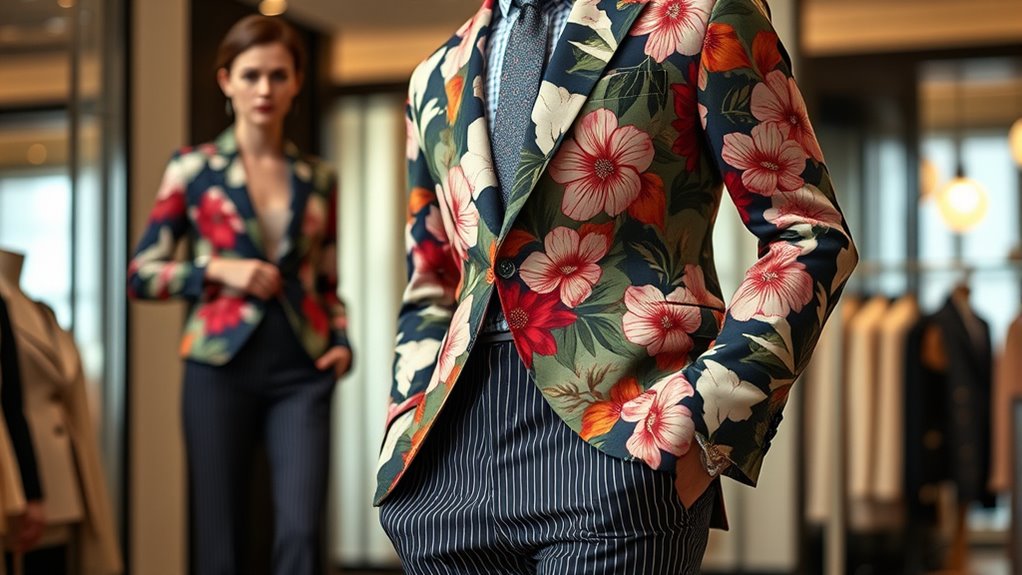
Mixing prints and patterns becomes more impactful when you consider scale and proportion. By varying the scale contrast, you create visual interest and prevent your look from becoming overwhelming. Pairing a large floral print with smaller, delicate patterns establishes a clear pattern ratio that feels balanced. When one pattern is dominant in size, the other should be subtler to avoid clashing. Adjusting the proportion of each print helps guide the eye smoothly across your outfit, making the combination look intentional and stylish. Think of scale as the visual weight of each pattern—large prints add boldness, while smaller ones bring finesse. Mastering this balance ensures your prints complement rather than compete, giving your ensemble a cohesive, polished appearance. Incorporating visual balance techniques from sound design can also help in achieving harmony in your outfit.
Use the 60-30-10 Color Rule to Harmonize Patterns
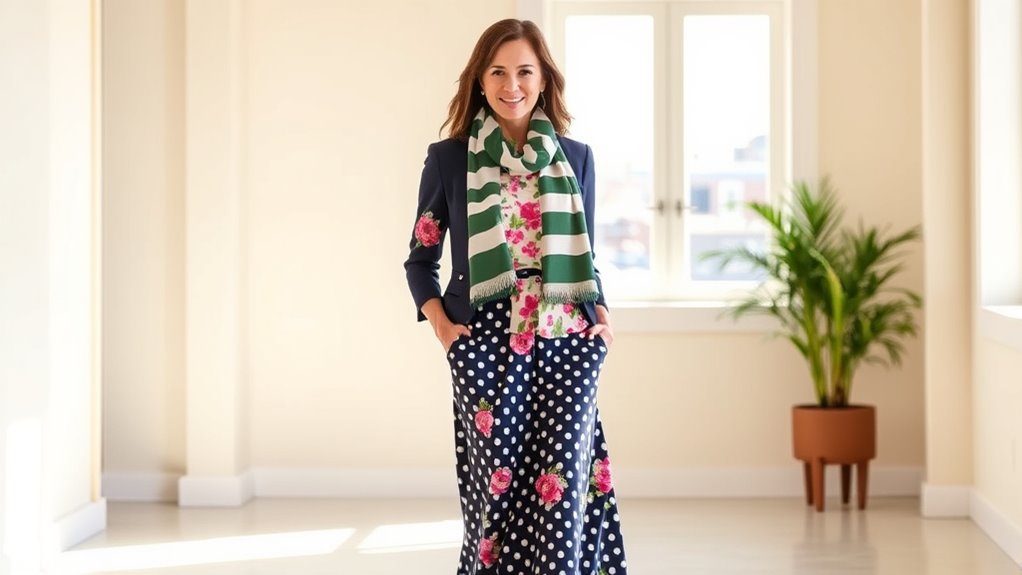
Applying the 60-30-10 color rule is an effective way to create harmony when mixing patterns. This rule helps you balance your look by assigning 60% of your outfit to a dominant color, 30% to a secondary color, and 10% to an accent. Use color blocking to separate patterns with solid hues that follow this ratio, ensuring they complement each other within a cohesive palette. Stick to farmhouse-style decor to make your prints work together seamlessly, avoiding clashes. For example, pair a floral pattern with a striped piece using shades from the same color family, with the dominant color in the background. This approach keeps your pattern mix visually appealing and unified, giving you confidence in creating stylish, coordinated outfits.
Accessorize Thoughtfully to Tie the Look Together
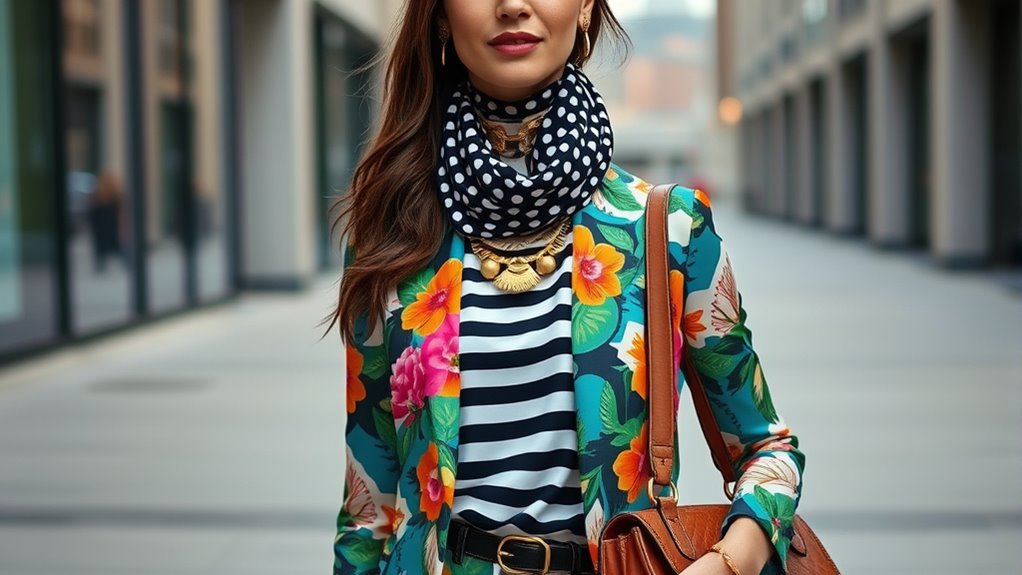
To create a polished look when mixing prints and patterns, thoughtful accessorizing is essential. Matching jewelry helps unify your outfit, so choose pieces that complement the colors or themes within your patterns. For example, if your prints include gold accents, incorporate gold jewelry to tie everything together seamlessly. Belt styling is equally important; select a belt that either matches your dominant color or adds a subtle contrast. A sleek belt can define your waist and connect different patterns, creating a cohesive appearance. Keep accessories simple if your patterns are bold, or go for statement jewelry if your prints are more subdued. Thoughtful accessorizing balances the look and ensures your pattern mixing appears intentional and stylish. Incorporating color coordination ensures all elements work harmoniously, making your outfit appear thoughtfully curated.
Frequently Asked Questions
Can Mixing Prints Make Me Look Larger or Smaller?
Mixing prints and patterns can create optical illusions that influence your perceived size. Bold, large prints might make you look larger, while smaller, subtle patterns can help you appear smaller. You can achieve visual balance by pairing a busy pattern with a solid color or simpler print. This technique helps control how your body is perceived, making you look proportionate and confident. Experimenting with different patterns allows you to master flattering, stylish looks.
Are There Specific Patterns That Clash More Than Others?
They say “beauty is in the eye of the beholder,” but when it comes to pattern clash, some combos just don’t work. Bold, busy patterns like florals and abstracts tend to clash more than subtle stripes and polka dots. To achieve harmonious mixing, stick to patterns with similar scales or colors. Avoid pairing large and tiny prints, which can create visual chaos instead of a stylish balance.
How Do I Choose Prints Suitable for My Skin Tone?
You should choose prints that suit your skin tone by focusing on color harmony. If you have warm undertones, opt for prints with earthy hues like browns, oranges, and golds. For cool undertones, go for patterns featuring blues, purples, and jewel tones. Consider your skin’s brightness and contrast to select prints that enhance your natural glow. This approach guarantees your print choices complement your skin tone beautifully.
Is It Appropriate to Mix Prints for Professional Settings?
Mixing prints in professional attire can feel like walking a tightrope, but it’s doable if you follow office wear guidelines. You can confidently pair subtle patterns like pinstripes with small florals or checks, keeping the overall look polished. Just remember, less is more—choose complementary colors and scale patterns thoughtfully. When done right, mixing prints adds personality while maintaining professionalism, making you stand out in the best way.
How Do Seasonal Trends Influence Print Mixing Choices?
Seasonal trends greatly influence your print mixing choices, reflecting the latest colors, motifs, and textures. As print mixing evolves, you’ll notice designers favoring specific patterns each season, guiding your wardrobe updates. By staying aware of seasonal trends, you can confidently experiment with print combinations that feel fresh and relevant. This awareness helps you adapt your style effortlessly, ensuring your print mixing stays modern and on-point throughout the year.
Conclusion
By mastering these tips, you’ll turn your wardrobe into a vibrant tapestry of style. Think of mixing prints as painting with your clothes—each pattern a brushstroke blending seamlessly into a masterpiece. With confidence, you’ll weave bold hues and intricate textures into a harmonious story. So, embrace the adventure, experiment fearlessly, and watch your outfits become a colorful symphony that captures attention and sparks admiration wherever you go.



